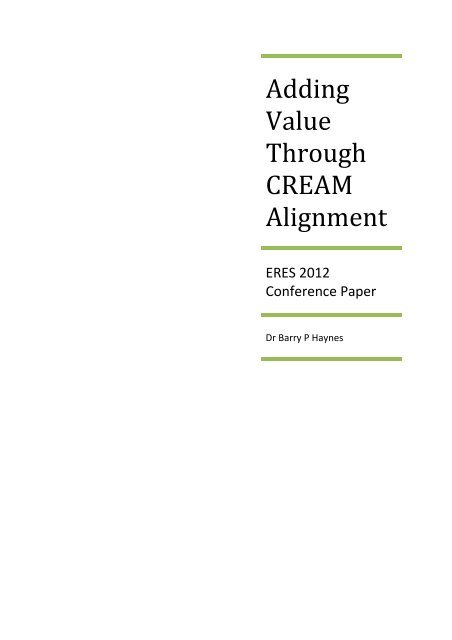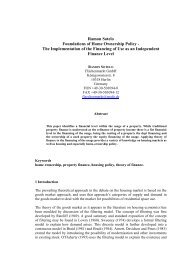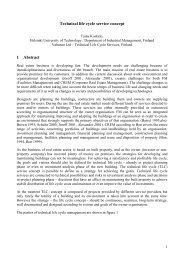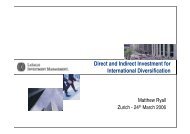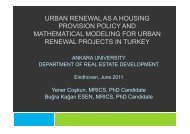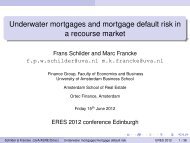Adding Value Through CREAM Alignment
Adding Value Through CREAM Alignment
Adding Value Through CREAM Alignment
You also want an ePaper? Increase the reach of your titles
YUMPU automatically turns print PDFs into web optimized ePapers that Google loves.
<strong>Adding</strong><strong>Value</strong><strong>Through</strong><strong>CREAM</strong><strong>Alignment</strong>ERES 2012Conference PaperDr Barry P Haynes
<strong>Adding</strong> <strong>Value</strong> <strong>Through</strong> <strong>CREAM</strong> <strong>Alignment</strong> 2012AbstractPurpose: This paper aims to evaluate the relationship between corporate strategy andCRE strategyDesign/methodology/approach: The paper will identify, and evaluate, a number ofcomponents that collectively form the CRE strategy. Linkages between the businessenvironment, the aims and objectives of the organisation and the real estate solution willbe explored.Findings: The paper will illustrate the alignment of the CRE strategy to the corporatestrategy through the development of a CRE alignment model. The model willdemonstrate that only when optimum alignment is achieved can the CRE strategy deliveradded value and enhanced organisational performance.Practical Implications: CRE managers can use the model to evaluate the alignment oftheir CRE strategy with their corporate strategyOriginality/<strong>Value</strong>: The paper fills a void by proposing a framework that seeks to identifythe true impact of real estate to business by examining the benefits of optimal alignmentbetween, planet, position, purpose, place, paradigm, processes and people to produceperformance and productivity.IntroductionOver the last 20 years there has been a clear development, both in academic andprofessional terms, in Corporate Real Estate Management (CREM). CREM hasdeveloped into a strategic management discipline that requires the same amount ofattention as other strategic disciplines. The primary aim of CREM is to enhance theperformance of the client organisation through the alignment of the corporate real estate(CRE) strategy with the organisational strategy.Haywood (2011) reviewed the CREM literature to evaluate theoretical models that haveattempted to establish the linkage between CREM and organisational strategy. Haywood(2011) makes the point that the existing approaches to CRE alignment tend to fall intoone of two camps. The alignment models are either single CRE factor or are multivariatealignment models (Heyward 2011). Heywood (2011) identified 10 different alignmentmodels which included components ranging from 7 to 15. Whilst the multivariateapproach may offer a more detailed understanding of the relationship between CRE andorganisational strategy it also raises a number of fundamental questions:• What are the components of CREM?• What would be an appropriate theoretical framework for CREM?• And, how do these components interact in a multivariate way?This paper aims to address the first two questions with the third question being left forfuture research. The proposed alignment model is contained in Figure 1. The premise of2 | P a g e
<strong>Adding</strong> <strong>Value</strong> <strong>Through</strong> <strong>CREAM</strong> <strong>Alignment</strong> 2012PlanetThe planet component of the model relates to the alignment of CRE with issues relatingto sustainability and corporate social responsibility. It appears that organisations arebecoming increasingly aware of their green credentials with some organisations usingthis as their unique selling point. CRE can play a significant role by ensuring thatbuildings are designed, built and managed with energy efficiency at the centre of thedecision-making process. Part of this process will be ensuring that the building has theappropriate sustainability certification such as; BREEAM, LEED, CASBEE and GreenStar.Cornet Global has undertaking a number of research initiatives relating to the trends inCRE. The aim is to establish the demands for CRE in 2020. Part of this initiative was apiece of research which investigated the impacts trends in sustainability will have onCRE provision. The research team propose six major findings which include (Shen, Ngand Varcoe 2012):• A trend towards increased transparency of energy use and carbon footprint whichwill be driven by regulatory initiatives. The initiatives that acknowledge energyefficiency and penalise inefficient energy usage will be increasingly moreimportant by 2020.• Buildings will be not only be consumers of energy but also producers of energythrough the use installations that use of technologies such as solar energy andwind generated energy.• Real estate strategy will be influenced by access to reliable and renewableenergy, potable water and waste distribution.• Technology will enable greater monitoring and control of energy efficiency ofbuildings. In addition, it will provide office occupiers the opportunity to work moreflexibly, thereby reducing the requirement for the daily commute and also theneed for corporate travel.• 74% of respondents to the Cornet global 2020 survey reported that initiativesundertaken by CRE managers can positively change personal behaviour andstandards of employees regarding sustainability.• There will be an increasing trend towards a higher level of in-house sustainabilityexpertise.PositionThe position component helps to set the context in which any CRE decisions have to bemade. This is achieved by establishing an understanding of the “drivers for change” thatare taking place in the business environment. In addition, this component can also relateto the position of the organisation in the business cycle. An expanding organisation hasdifferent requirements to a restructuring or contracting organisation.Business environments are becoming more complex, with companies wanting torespond more quickly, and even globally, to changing market conditions. Set against thechanging business environment, establishing CRE requirements has become a morecomplex task. It is therefore important that CRE managers and consultants understand,and can apply, a range of environmental scanning techniques such as PEST and SWOTanalysis. Even innovative techniques such as Scenario Planning techniques have a roleto play in strategic real estate management (Haynes and Nunnington 2010).4 | P a g e
Purpose<strong>Adding</strong> <strong>Value</strong> <strong>Through</strong> <strong>CREAM</strong> <strong>Alignment</strong> 2012The purpose component adds to the position component in that the CRE manager needsto understand the organisation's response to the changing business environmentthrough establishing the business aims and objectives. This includes the companymission or vision statement and aims to establish the future direction of the business.Research undertaken by Lindholm et al (2006) proposed that corporate strategies couldbe one of two options. The options being: revenue growth or profitability growth. Thiswould lead to 7 possible real estate strategies which include:1. increased value of assets2. promote marketing and sales3. increase innovations4. increase employee satisfaction5. increase productivity6. increase flexibility7. reduce costsA number of authors have proposed CRE alignment models (Appel-Meulenbroek et al.2010). Eight such models are evaluated by Appel-Meulenbroek et al (2010). Within theirreview a number of authors adopted 9 corporate strategies proposed by Tregoe andZimmerman (1980). Which are (Tregoe and Zimmerman 1980):1. products offered2. market needs3. technology4. production capacity5. method of sale6. method of distribution7. natural resource8. size/growth9. return/profitAppel-Meulenbroek et al (2010) aimed to evaluate strategic alignment of corporate realestate in the care sector in the Netherlands by interviewing 20 experts. The interviewsrevealed that two of the driving forces identified by Tregoe and Zimmerman (1980) werenot appropriate for the care sector. Those being: “method of distribution” and “naturalresources”. The experts interviewed also identified an extra real estate strategyappropriate for the Dutch care sector called “increase clients satisfaction”. The extrastrategy was in addition to the 7 proposed by Lindholm et al (2006). Appel-Meulenbroeket al (2010) calls for further research having identified that it is hard to find a definitealignment mechanism as ultimately the alignment evaluation will be based on expertknowledge which is not always available in a CREM Department (Appel-Meulenbroek etal. 2010).ProcurementThe decisions involved in deciding your CRE procurement have become more complexgiven the changing business environment. The procurement option chosen by the CREmanager is a pivotal decision that will determine the success of the CRE strategy. This isbrought into sharp focus by the demands of an organisation for flexibility and adaptabilitywhilst at the same time the CRE manager has to deal with lead times for acquisition and5 | P a g e
<strong>Adding</strong> <strong>Value</strong> <strong>Through</strong> <strong>CREAM</strong> <strong>Alignment</strong> 2012disposal of property. Given these constraints it is understandable that the CRE managermay consider leasing rather than owning CRE.This view is supported by a piece of research that evaluates UK quoted companies overa period between 1989 and 2002, which identified a trend in high-growth and largecompanies towards leasing rather than owning freehold real estate (Lasfer 2007).However, the research also identified, through the Donaldson's-Lasfer’s curve, anoptimum relationship between a firm’s value and the leasing propensity. A balance isrequired between freehold and leasehold ownership. This optimum level of leasing isaround 65% (Lasfer 2007).Whilst the financial element of the lease versus buy (LVB) decision is an importantcomponent it is not the only one. Barkham & Park (2011) evaluate empirical researchobtained from 2,248 UK firms regarding their LVB decision. Their research proposes theneed for a wider framework to fully evaluate LVB decisions for CRE which not onlyincludes finance but also includes corporate strategy, locational analysis, and real estateeconomics. It is acknowledged that the dataset on which this research is based wascollected in 1998 but it still develops our appreciation of CRE and establishes the needfor understanding the interrelationship between corporate strategy (purpose), the LVBdecision (procurement), and the location of the property (place).PlaceIn the context of CRE the place component can relate to macro decision-making factorssuch as which country and which city the corporate head office be located in. It can alsorelate to the micro decision-making factors such as the specifications of the building andthe layout required in the office environment.The European cities monitor, produced by Cushman and Wakefield, is a survey that hasbeen produced since 1990 (McCarthy 2011). The survey identifies the perceptions thatcorporations have about cities across Europe. The findings in the survey allowcorporations to evaluate the relative attractiveness of the different European cities. Thesurvey is obtained from 501 European companies and obtains senior executives viewson Europe’s leading business cities. This survey is useful as it identifies the factorswhich companies believe are the most important when considering locating theirbusiness. The 2011 survey identified the most important factor to be easy access tomarkets, customers or clients (60%) (McCarthy 2011). This was followed by availabilityof qualified staff (53%). <strong>Value</strong> for money of office space appeared fifth on the list ofimportant factors with a response rate of 33%. This indicates that whilst companies areconscious of costs it is more important to locate nearer to their customers.Once a country and a city have been located the next challenge facing the CREmanager is to identify a building with specifications that matches their organisationalneed. However, there needs to be clearly identified assessment criteria against whichthe CRE manager can evaluate potential locations and buildings (Nunnington andHaynes 2011). This is a complex decision-making progress that requires objectivity andtransparency. It also requires strategic emphasis on business requirements and not justobtaining the best real estate deal (Nunnington and Haynes 2011).6 | P a g e
Paradigm<strong>Adding</strong> <strong>Value</strong> <strong>Through</strong> <strong>CREAM</strong> <strong>Alignment</strong> 2012The CRE manager needs to establish how an organisation actually works andunderstand the beliefs and values espoused by the client organisation so that the realestate and workplace solutions can support and enhance the culture of the organisationor "organisational DNA". It is also important to establish micro cultures, the way thatpeople actually work in the office environment; this could be considered to be the"workplace DNA".The brand of an organisation is more than the marketing materials and the companylogo; it has to reflect the whole ethos of the organisation. It is the ethos, or brand identity,that helps an organisation differentiate itself in the market place (Haynes andNunnington 2010).An organisation can use its real estate and facilities to communicate clearly toemployees and customers its brand identity. The location of an organisation's buildings,their external and internal design and appearance all send signals about the companyculture and brand (Haynes and Nunnington 2010).A successful brand will be fully integrated into the business: it will reflect the culture of theworkplace, the values of the organisation, the perceptions of customers and clients, even thenature of the business’s assets (McNestrie 2009).Branding is strongly associated with the consumer and retail sector. However, it canperform just as important a role in office working environments. The branding of officeenvironments can clearly reflect the culture of an organisation, or corporate DNA. If thereal estate and facilities professionals are not consciously managing the brand of acompany, then by default they may be sending negative signals to their customers andemployees (Haynes and Nunnington 2010).ProcessesTo ensure that the building provision and specifications matches the organisationaldemand for space requires the CRE manager to have a clear understanding of the workprocesses undertaken in the organisation.Research undertaken by Greene and Myerson (2011) aimed to establish differentclassifications of knowledge workers based on their mobility patterns. This research wasnovel in a sense that along with interviews and ethnographic studies the research used adrawing exercise in the interview process as a way of graphically capturing theinterviewees’ perception of their office mobility. This research identified four charactertypes for knowledge workers. The anchor and the connector were mainly confined to theoffice environment whilst the gatherer and navigator were more mobile and had thefreedom to roam away from the office environment (Greene and Myerson 2011). Clearlyestablishing the needs of office-based occupiers and mobile workers is an essentialelement in identifying the office space requirements.The matching of processes to place is a fundamental one and is developed even furtherby research undertaken by Duffy et al (2011) who argues that context and purposeshould also be taken into account. This research argues that the creative processes of7 | P a g e
<strong>Adding</strong> <strong>Value</strong> <strong>Through</strong> <strong>CREAM</strong> <strong>Alignment</strong> 2012discovery sharing and pushing knowledge forward should not be restricted bypredetermined physical workspaces (Duffy, Craig and Gillan 2011). This call for a moreadaptive approach to workplaces requires the CRE manager to apply more socialscience research skills to understanding the needs and preferences of the officeoccupiers.PeopleIncreasingly, the CRE manager has to identify the needs and preferences of officeworkers. To really understand office occupiers’ needs the CRE manager has to establishnot only the work process requirements, as previously described, but also thepsychological needs of office occupiers (Oseland 2009). This adds another layer ofcomplexity to establishing workplace requirements but is essential if the officeenvironment is to support the needs of the individual as well as the needs of theorganisation.A review on the main psychological theories and their impact of the design andmanagement of office environments is presented by Oseland (2011). This review arguesthat there is a need for effective use of space by placing individual needs, as well asorganisational needs, at the centre of office design. A view of the key theories identifiedby Oseland (2011) are summarised below:• Locus of control: This relates to an individual's perceptions of how events arecontrolled (Rotter 1966). People who have “internal” locus of control believe thatit is their own decisions that determine their own rate. In contrast people have“external” locus of control believe that events are determined by an externalforce. Oseland (2011) proposes that internals are more likely to adapt to flexibleworking whereas internals may require more supervision and therefore may bemore suited to open plan environments• Space territory and privacy: Oseland (2011) uses Hall’s (1963) ProxemicFramework to illustrate peoples preferred distances when interacting in the officeenvironment. Oseland (2011) argues that smaller desk allocations such astouchdown desks may actually impact on individuals’ personal space leading to afeeling of intrusion.• Social group: Oseland (2011) applies the research of Robin Dunbar to the officeenvironment and concludes that office environments that have floor plates thataccommodate staff of more than 150 can potentially be overwhelming to theoffice occupiers. The “Dunbar number” states that people are comfortable with asocial group of around 150 members (Dunbar 1993).ProductivityDesigning productive working environments requires the integration of the componentspreviously discussed in this paper. It is only when all the components are in alignmentthe workplace can be productive on an individual and an organisational basis. Therefore,workplace alignment means that the workplace supports the organisational purpose andculture, in addition to the work processes and individual needs and preferences of theoffice occupiers.To ensure that a best match between office occupiers and their office environment isachieved, there needs to be an alignment of both the physical environment and thebehavioural environment (Haynes 2007; Haynes 2008). The physical environmentrelates to the office layout and how comfortable office occupiers feel in the office8 | P a g e
<strong>Adding</strong> <strong>Value</strong> <strong>Through</strong> <strong>CREAM</strong> <strong>Alignment</strong> 2012environment. Office layout relates to such things as: size and positioning of desks inaddition to the location of printers photocopiers etc. Whilst the office comfort relates tosuch things as: ventilation, heating, lighting etc. The behavioural environment relates tothe way that people interact in the office environment. This can be through interactionsand distractions (Haynes 2007; Haynes 2008). It has been identified that it is thebehavioural environment, more than the physical environment, that has the most impacton people's perceived productivity (Haynes 2007; Haynes 2008).PerformanceThe demands on the CRE manager require both efficient and effective CRE provision.Efficiency can be demonstrated by cost reduction and is typified by efficiency measuressuch as cost/m2. Effectiveness can be demonstrated by how well the CRE departmentadds value to the organisation. This could take the form of a hybrid metrics such asrevenue/m2 or profit/m2. There is a need for performance metrics that demonstrateeffectiveness as well as efficiency.One approach to broadening the performance metrics of CRE would be to use thebalanced scorecard (Kaplan and Norton 1996). Lindholm and Nenonen (2006)interviewed 26 CRE executives to establish a conceptual framework for CREmeasurement (Lindholm and Nenonen 2006). They propose that the balanced scorecardapproach can be adopted for CRE and propose metrics for the four components of thebalanced scorecard. The four components of the balanced scorecard are:• the financial perspective• the business process perspective• the learning and growth perspectives• the customer perspectiveThe debate for new corporate real estate metrics is broadened by Barnes et al (2011)who propose the need for metrics to be linked to corporate social responsibility (CSR).They acknowledge that there has been growth in mobility/alternative work patterns, butsuggest that the linkage is between mobility and CSR have not fully been established.Therefore, three components that link mobility to CSR are proposed (Barnes, Roose andPerske 2011).• Employee transport. This relates to an employee’s commute to work and anycommutes between facilities in the company.• Health/well-being. This relates to an employee's ability to establish a work lifebalance. Allowing employees the flexibility of mobile working means that they canreduce their commute time thereby reducing commuter stressors.• Community involvement. Adopting alternative workplace strategies means thatemployees are saving commuting time which they could use on social projects.A case study with six English fire and rescue services (FRS) developed a performanceframework for measuring real estate performance for multiple building types (Eckley andHedley 2011). They developed a performance scorecard based on IPD occupiers’ threepillars of performance which are efficiency, effectiveness and sustainability. Each pillar ofthe performance scorecard contained three levels of measurement. This allowed KPI's tobe operationalised into specific metrics of measurement. The findings of the case study9 | P a g e
<strong>Adding</strong> <strong>Value</strong> <strong>Through</strong> <strong>CREAM</strong> <strong>Alignment</strong> 2012indicate that UK FRS could save at least £30m ($47 million) per year. (Eckley andHedley 2011).There is a trend to move to measures that integrate the property performance metricswith the business performance metrics. This contemporary approach allows the realestate professionals to report back to the organisation the real estate performance interms that the business can understand. Adopting this strategic approach to propertyperformance measurement allows the real estate professionals to constantly evaluatetheir real estate provision to see how well it supports organisational need.ConclusionsThis paper has argued the need for a theoretical framework that underpins therelationship between corporate strategy and CRE strategy. The paper proposes anumber of components that could be included in the theoretical framework. Thetheoretical framework proposes that only when optimum alignment is achieved can theCRE strategy deliver added value and enhanced organisational performance.To develop this area of research further and number of steps need to be followed suchas:• Establish if the theoretical model includes all conceptual components.• Ensure that each conceptual component can be operationalised so thatmeasurement and evaluation can be undertaken.• Establish the linkages between components so that a true multivariate frameworkcan be developed.Bibliography and ReferencesAPPEL-MEULENBROEK, R, et al. (2010). Strategic alignment of corporate real estate.In: European Real Estate Society (ERES) Conference, European Real Estate Society,Milan, Italy, June.BARKHAM, R and A.U, Park (2011). Lease versus buy decision for corporate real estatein the UK. Journal of Corporate Real Estate, 13 (3), 157-168.BARNES, J, ROOSE, C and PERSKE, K (2011). Building the bridge: Positioningcorporate real estate for the new corporate metrics. The Leader, September/October,30-34.BONDE, M (2012). Difficulties in changing existing leases - one explanation of the"energy paradox". Journal of Corporate Real Estate, 14 (1), 63-76.DIXON, M and ROSS, P (2011). Work: measuring the benefits of agility at work.Regus/Unwired.DUFFY, F, CRAIG, D and GILLAN, N (2011). Purpose, process, place: design as aresearch tool. Facilities, 29 (3/4), 97-113.10 | P a g e
<strong>Adding</strong> <strong>Value</strong> <strong>Through</strong> <strong>CREAM</strong> <strong>Alignment</strong> 2012DUNBAR, R.I.M (1993). Coevolution of neocortical size, group size and language inhumans. Behavioral and Brain Sciences, 16 (4), 681-735.ECKLEY, A and HEDLEY, C (2011). A lesson in benchmarking: Measuring real estateperformance for multiple building types. The Leader, November/December, 32-34.ECKLEY, A and HEDLEY, C (2011). A lesson in benchmarking: Measuring real estateperformance for multiple building types. The Leader, November/December, 32-34.ELLIOTT, L, PICARIELLO, L and YANG, H (2011). Opportunity emerges from crisis:Global corporate real estate survey 2011. [online]. Last accessed 8 5 2012 at:http://www.joneslanglasalle.com/MediaResources/AP/Marketing/Singapore/CRE_Global_Survey_2011_Final.pdfGIBSON, V and LUCK, R (2006). Longitudinal analysis of corporate real estate practice:Changes in CRE strategy policies, functions and activities. Facilities, 24 (3/4), 74-89.GREENE, C and MYERSON, J (2011). Space for thought: designing for knowledgeworkers. Facilities, 29 (1/2), 19-30.HAYNES, B.P (2007). An evaluation of office productivity measurement. Journal ofCorporate Real Estate, 9 (3), 144-155.HAYNES, B.P (2008). An evaluation of the impact of office environment on productivity.Facilities, 26 (5/6), 178-195.HAYNES, B.P (2011). The impact of generational differences on the workplace. Journalof Corporate Real Estate, 13 (2), 98-108.HAYNES, B.P (2008). Impact of workplace connectivity on office productivity. Journal ofCorporate Real Estate, 10 (4), 286-302.HAYNES, B.P (2009). Research design or the measurement of perceived officeproductivity. Intelligent Buildings International, 1 (3), 169-183.HAYNES, Barry P (2009). Research design or the measurement of perceived officeproductivity. Intelligent Buildings International, 1 (3), 169-183.HAYNES, B.P and NUNNINGTON, N (2010). Corporate Real Estate Asset Management:Strategy and Implementation. Oxford, Elsevier.HEYWARD, C (2011). Approaches to aligning corporate real estate and organisationalstrategy. In: European Real Estate Society (ERES) Conference, European Real EstateSociety, Endhoven, The Netherlands, June.JOY, A and HAYNES, B.P (2011). Office design for the multi-generational knowledgeworkforce. Journal of Corporate Real Estate, 13 (4), 216 – 232.KADZIS, R (2012). 2012 State of the Industry: Corporate real estate in redefined world.CoreNet Global.KADZIS, R (2011). How Business Is Chainging: Corporate Real Estate Touchstones.[online]. Last accessed 8 5 2012 at:http://www2.corenetglobal.org/dotCMS/kcoAsset?assetInode=1176132311 | P a g e
<strong>Adding</strong> <strong>Value</strong> <strong>Through</strong> <strong>CREAM</strong> <strong>Alignment</strong> 2012KAPLAN, R.S and NORTON, D.P (1996). The Balanced Scorecard: Translating Strategyinto Action. Boston, MA., Harvard Business School Press.KNIGHT, C and HASLAM, A (2010). The relative merits of lean, and reached andempowered offices: An experimental examination of the impact of workspacemanagement strategies on well-being and productivity. Journal of ExperimentalPsychology, 16 (2), 158-172.LAIHONEN, H, et al. (2012). Measuring the productivity impacts of new ways of working.Journal of Facilities Management, 10 (2), 102-113.LASFER, M (2007). On the financial drivers and implications of leasing real estateassets: The Donaldsons-Lasfer's Curve. Journal of Corporate Real Estate, 9 (2), 72-96.LINDHOLM, A-L, GIBLER, K.M and LEVAINEN, K.I (2006). Modelling the value-addingattributes of real estate to the wealth maximisation of the firm. Journal of Real EstateResearch, 28 (4), 445-474.LINDHOLM, A-L and NENONEN, S (2006). A conceptual framework of CREM. Journalof Corporate Real Estate, 8 (3), 108-119.MCCARTHY, F (2011). European cities monitor 2011. [online]. Last accessed 8 5 2012at:http://www.cushwake.com/cwglobal/jsp/kcReportDetail.jsp?Country=GLOBAL&Language=EN&catId=100003&pId=c38200001pMCCARTHY, F (2011). European City Monitor 2011. [online]. Last accessed 15 5 2012at:http://www.cushwake.com/cwglobal/jsp/kcReportDetail.jsp?Country=GLOBAL&Language=EN&catId=100003&pId=c38200001pMCDONAGH, J (2008). The development of corporate real estate asset management inNew Zealand. Journal of corporate real estate, 10 (3), 183-195.MCDONAGH, J and NICHOLS, G (2009). business strategy and property strategy-howstrong is the linkage? Journal of Corporate Real Estate, 11 (4), 213-228.MCMILLAN, R and HUGHES, R (2011). The new lease accounting rules: An overview ofthe proposals' impact on corporate real estate. [online]. Last accessed 8 5 2012 at:http://www.rics.org/site/scripts/download_info.aspx?downloadID=6846&fileID=8796MCNESTRIE, A (2009). Strike up the brand. FMWorld, February, 47-49.NOURSE, H.O and ROULAC, S.E (1993). Linking Real Estate Decision to CorporateStategy. Journal of Real Estate Research, 8 (4), 475-494.NUNNINGTON, N and HAYNES, B.P (2011). Examining the building selection decisionmaking process with corporate relocations: to design and evaluate a client focused toolto support objective decision making. Journal of Corporate Real Estate, 13 (2), 109-121.O'MARA, M.A (1999). Strategy and Place: Managing Corporate Real Esatate andFacilites for Competative Advantage. New York, NY, The Free Press.OSELAND, N (2009). The impact of psychological needs on office design. Journal ofCorporate Real Estate, 11 (4), 244-254.12 | P a g e
<strong>Adding</strong> <strong>Value</strong> <strong>Through</strong> <strong>CREAM</strong> <strong>Alignment</strong> 2012OSELAND, N, et al. (2011). Environments for successful interaction. Facilities, 29 (1/2),50-62.OSGOOD, R.T (2004). Translating organisational strategy into real estate action: Thestrategy alignment model. Journal of Corporate Real Estate, 6 (2), 106-117.PORTER, M (1980). Competative Strategy. New York, The Free Press.PROPERTY INDUSTRY ALLIANCE AND CORENET GLOBAL (2011). 2011 OccupierSatisfaction Survey. [online]. Last accessed 8 5 2012 at:http://www.rics.org/site/download_feed.aspx?fileID=10416&fileExtension=PDFREGUS (2012). Flexibility drives productivity. Regus.ROPER, K (2001). Aligning corporate real estate with the business of your company.Journal of Corporate Real Estate, 3 (3), 222-231.ROTTER, J.B (1966). Generalised expectancies of internal versus external control ofreinforcements. Psychological Monographs, 80 (609),.ROULAC, S (2001). Corporate property strategy is integral to corporate businessstrategy. Journal of Real Estate Research, 22 (1/2), 129-151.SCHEFFER, J.J.L, SINGER, B.P and MEERWIJK, M.C.C Van (2006). Enhancing tehcontribution of coporte real estate to corporate strategy. Journal of Corporate RealEstate, 8 (4), 188-197.SHEN, T, NG, A and VARCOE, B (2012). Corporate Real Estate 2020 - Sustainability.[online]. Last accessed 17 April 2012 at:http://www2.corenetglobal.org/dotCMS/kcoAsset?assetInode=13244237SINGER, B.P., BOSSINK, B.A.G. and PUTTE, H.J.M. (2007). Corporate real estate andcompetitive strategy. Journal of Corporate Real Estate, 9 (1), 25-38.SMITH, A and PITT, M (2009). Sustianable workplaces; improving staff health and wellbeingusing plants. Journal of Corporate Real Estate, 11 (1), 52-63.TODD, S and HARGIS, S (2012). Corporate Real Estate 2020 Final Report: Workplace.CoreNet Global.VARCOE, B and O'MARA, M (2011). Corporate real estate impact on enterprisesuccess. Regus.iAsset management has been included in the title in an attempt to illustrate real estate as anorganisational asset and not just a liability. By shifting the emphasis to real estate as an assetthen the dialogue and communication with an organisation can relate to asset maximisation. Thisapproach acknowledges that real estate is an asset in a financial sense, included on the balancesheet, whilst also an asset in an operational sense and can lead to organisational performance(Haynes and Nunnington 2010).13 | P a g e


